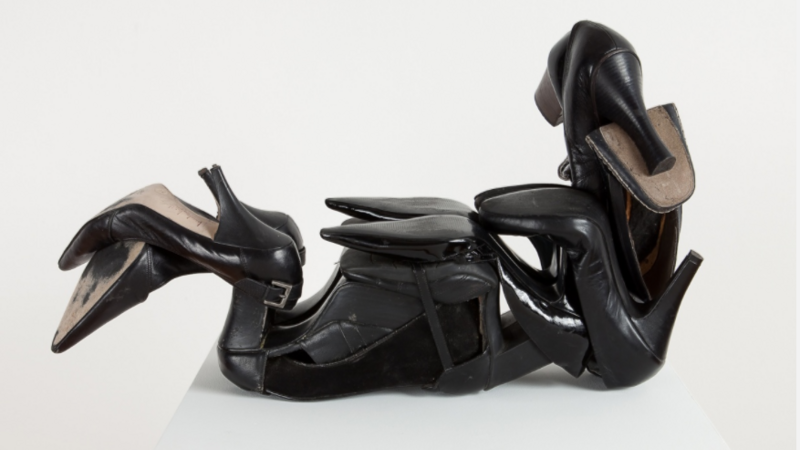At first glance, it looks like the back of my mother's closet- a pile of black heels in varying styles, none of which are particularly elaborate. Some have straps and buckles, others are plain. The sculpture is mostly comprised of black shoes, but some pairs add depth with shades of dark brown heels, tan soles, or thick white stitching. A few have the pointy toes that every girl dreads wearing because they're so painful, but wears anyway because there is power in strutting around on 4-inch stilts just because you can. As I spend more time with the sculpture, I begin to see that the mismatched shoes are bent and manipulated to take the shape of a woman, lying down on her belly with her head propped on her hands and her feet in the air with her ankles crossed. Rigid heels and pointed corners form the sharp angles of her elbows and knees, while soft arches form the sloping curves of her lower back and posterior thighs. She seems relaxed and carefree, like she's lying on a blanket on South Quad during the first few weeks of school, when the weather is perfectly mild, no longer suffocatingly humid and not yet bone-chillingly cold.
"Nicole Miller in Repose" looks fine from afar. It's when I look closely that her marks and scars become visible. Upon this closer look is when people typically make the mistake of justifying or minimizing imperfections. That is when the "I hardly noticed it!"s and the "You could cover it up!"s reflexively flow out of observers' mouths. I find myself falling into the same trap- criticizing the wearer's ability to walk in heels and suggesting that the scuffs could easily be fixed with some time, attention, and polish. But I catch myself, and ponder why I try to correct or dismiss imperfections when I know that unique beauty is found in the stories behind scars. Upon close inspection, Willie Cole's "Nicole Miller in Repose" is covered in scratches, marks, and scuffs that call out a demand for explanation which goes unanswered, prompting me to examine my tendency to minimize imperfections and my perceptions of beauty.
I find beauty in the explanations behind my own imperfections, so why can I so quickly minimize marks and scuffs that don't belong to me? I am often told that the scar beside my left eyebrow is "barely noticeable," but I would prefer to tell about how my mother was the attending physician in the Emergency Room when I needed the stitches that left the scar behind. I prefer to share how my mom cried while she sewed my 3-year old face because she was worried that I would remember it. That "barely noticeable" scar reminds me of my mom's entirely selfless love for me. So now, each scuff, scratch, and dirt mark that covers these shoes causes me to grow frustrated. How did each one come to be? Was the wearer of those black pumps rushing to an interview for her dream job when she caught her heel on the cobblestone sidewalk in the historic part of the city, leaving a permanent indent? Did her daughter dress up in the shoes that were left by the door, scuffing the soles as she shuffled along the floor in an effort to be just like her mom? I want to know the story behind every mark instead of dismissing each one, but I am left unfulfilled, with only the shoes in front of my eyes and no wearers to tell the story.
I circle around toward the figure's tilted head, and I notice the asymmetrical features of its face. I can see what seems to be the cheekbones and the jawline, but they don't quite match up, and I am immediately conscious of the way my teeth rest when my mouth is closed. Like "Nicole Miller in Repose," my face does not quite match up- my jaw lies to the left instead of in the center of my face. I'm not particularly bothered by my misaligned jaw because I think my crooked smile adds character. When others notice it, however, they tend to suggest that I have it fixed, because it would be a "glow up." Disappointedly, I find myself expressing similar sentiments about "Nicole Miller in Repose"- wondering why the artist didn't craft a perfect face, with the brown heels forming defined, even cheekbones, when he had the chance. I ponder whether he intentionally crafted an imbalanced face to prove that beauty can be found in quirks and peculiarity, or whether that was just how he felt that the shoes fit together best. Again, "Nicole Miller in Repose" leaves my analytical mind's thirst for concrete explanation unquenched. In searching for answers that the piece will not give, I am forced to examine the hypocrisy of my harsh judgements. Perhaps this is what Willie Cole intended- to leave no explanation, prompting me to look inwardly through the lens of his sculpture.
"Nicole Miller in Repose" shows me only what I perceive as imperfection; it does not allow me the opportunity to ask questions, nor does it offer me the stories that I long to know. The piece challenges me to take advantage of everyday opportunities for explanation, which may turn a small scuff into an illustration of a beautiful story. My judgment of the piece's misaligned features, scratches, and scuffs provokes me to examine the beauty that can be found in flaws, and to scrutinize my skewed perceptions of perfection.
Works Cited
Cole, Willie. Nicole Miller in Repose, 2011. Snite Museum of Art, University of Notre Dame.

